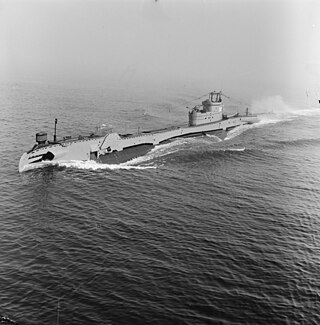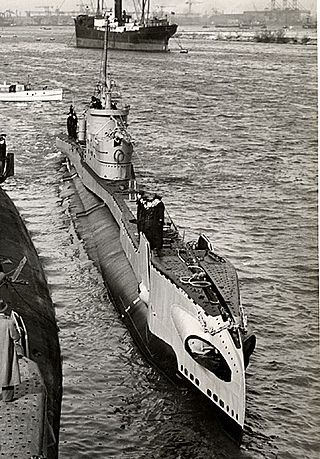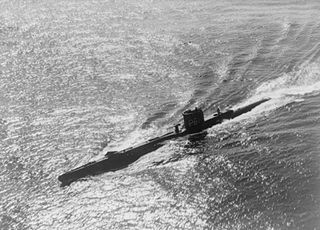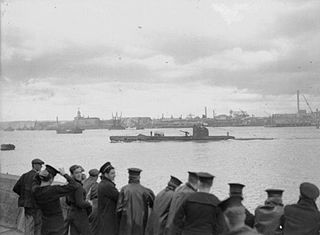Seven ships of the Royal Navy have been named Warspite. The origins of the name are unclear, although it is probably from the word spight – an Elizabethan-era spelling variation of both spite and speight – in part embodying contempt for the Navy's enemies, but which was also the common name for the green woodpecker, suggesting the 'Warspight' would poke holes in enemy ships' (wooden) hulls. Until 1919 a woodpecker was used as the ships' crest; the official badge was a cannon, although the woodpecker continued to be used on the ships' tompions or gun muzzle plugs. Warspite carries the most battle honours of any ship in the Royal Navy, with the sixth Warspite being awarded fifteen of them.
Seven ships of the British Royal Navy have been named HMS Orion, after the hunter Orion of Greek mythology:

The Loch class was a class of anti-submarine (A/S) frigate built for the Royal Navy and her Allies during World War II. They were an innovative design based on the experience of three years of fighting in the Battle of the Atlantic and attendant technological advances. Some shipyards had trouble building these larger ships, which led to widespread use of the Castle-class corvette, introduced around the same time.

The British U-class submarines were a class of 49 small submarines built just before and during the Second World War. The class is sometimes known as the Undine class, after the first submarine built. A further development was the British V-class submarine of 1942.

HMS Tapir (P335) was a Second World War British T-class submarine, built by Vickers-Armstrong in Barrow-in-Furness. So far she has been the only ship of the Royal Navy to bear the name Tapir, after the animal.

HMS Tenacious was a T-class destroyer of the Royal Navy that saw service during the Second World War. She was built by Cammell Laird, of Birkenhead and launched on 24 March 1943.

The British V-class submarine was a class of submarines built for the Royal Navy during the Second World War.

The Shoreham-class sloops were a class of eight warships of the Royal Navy built in the early 1930s.

HMS Scorcher was an S-class submarine of the Royal Navy, and part of the third group built of that class. She was built by Cammell Laird and launched on 18 December 1944. So far she has been the only ship of the Royal Navy to bear the name Scorcher. She was launched by Thomas Beacham, a Foreman Driller employed by Cammell Laird.

HMS Spark was a S-class submarine of the third batch built for the Royal Navy during World War II. She survived the war and was scrapped in 1950.

HMS Tabard was a British submarine of the third group of the T class. She was built by Scotts, Greenock, and launched on 21 November 1945. So far she has been the only boat of the Royal Navy to bear the name Tabard, after the item of clothing. Having been launched after the war, she was selected, along with a number of boats of her class, to try out new streamlining techniques based on the German Type XXIII submarine. In May 1963, she was involved in a collision with HMAS Queenborough, and on 10 February 1964 she underwent exercises with HMAS Melbourne and HMAS Voyager in the hours before their collision. When she returned to the UK, she became the static training submarine at the shore establishment HMS Dolphin, until 1974 when she was sold and broken up.

HNLMS Tijgerhaai (P336) was a Zwaardvisch-class submarine of the Royal Netherlands Navy during and after World War II. She was originally ordered as HMS Tarn (P326), a British T-class submarine, built by Vickers Armstrong, Barrow, but never saw service under that name. She would have been the only ship of the Royal Navy to bear the name Tarn.

HMS Taurus was a Second World War T-class submarine, built by Vickers Armstrong, Barrow.

HMS Varangian was a British built U class submarine, a member of the third group of that class to be built. The submarine carried out patrols in the Norwegian Sea and was also used in a training role. She was broken up at Gateshead in 1949. Her ship's bell is in the possession of the Royal Navy Submarine Museum in Gosport, United Kingdom.

HMS Ultimatum (P34) was a Royal Navy U-class submarine built by Vickers-Armstrong at Barrow-in-Furness, and part of the third group of that class. So far she has been the only ship of the Royal Navy to bear the name Ultimatum.

HMS Unbroken (P42) was a Royal Navy U-class submarine built by Vickers-Armstrong at Barrow-in-Furness; it was part of the third group of that class and has been the only vessel of the Royal Navy to bear the name. She entered service as P42 and was renamed Unbroken on 1 February 1943.

The Bridgewater-class sloop was a class composed of two sloops built for the Royal Navy, HMS Bridgewater and HMS Sandwich. The ships were part of the Royal Navy's 1927 Build Programme as replacements for the Flower-class sloop.

HMS Untamed was a Royal Navy U-class submarine built by Vickers-Armstrongs, High Walker. So far, she has been the only ship of the Royal Navy to bear the name Untamed. On 30 May 1943, she sank during a training exercise in the Firth of Clyde with the loss of all 35 of her crew. Untamed was subsequently salvaged and renamed HMS Vitality, another unique name, and lasted until 1946 when she was scrapped.

HMS Nene was a River-class frigate, designed for anti-submarine operations, that served with the Royal Navy during the Second World War. In 1944 she was loaned to the Royal Canadian Navy and recommissioned as HMCS Nene, who returned her to the Royal Navy in 1945. Following the war she remained in reserve until disposed of in 1955.

HMS Hare (J389) was a steam turbine-powered Algerine-class minesweeper during the Second World War. She survived the war and was sold to Nigeria in 1958 as HMNS Nigeria.


















